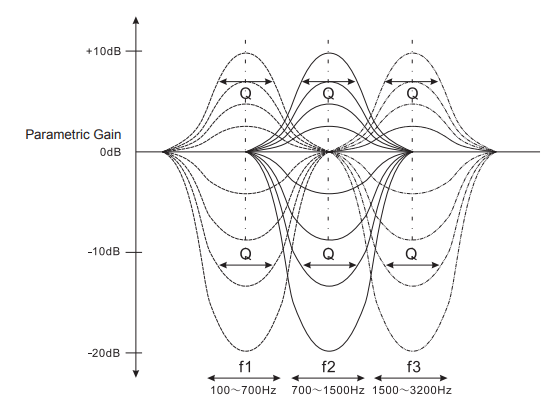The Yaesu FT-710 offers parametric equalizer (EQ) settings, allowing users to adjust the audio frequency response to tailor it to their preferences or compensate for specific voice or operating environment characteristics. This flexibility allows for precise customization of the audio response to achieve optimal clarity and intelligibility, especially in noisy or challenging operating environments. The FT-710 includes center frequency, bandwidth (Q), and gain parameters for three bands: Low (EQ1), Mid (EQ2), and high (EQ3.)
The FT-710 has two groups of settings where you can modify the frequency response: “PRMTRC” for when the speech processor is off and “P PRMTRC” for when the speech processor is on.
Here’s a breakdown of the three-stage parametric equalizer adjustments:
- Center Frequency (FREQ): This is the frequency around which the EQ adjustment will be centered. Yaesu’s parametric EQ settings usually allow users to select the center frequency they want to adjust. Different transceivers may offer different ranges of center frequencies, but standard options on the FT-710 include bass frequencies (lower range), midrange frequencies, and treble frequencies (higher range).
- Bandwidth or ‘Q’ (BWTH): This parameter determines the width of the frequency range around the center frequency affected by the EQ adjustment. A higher Q value narrows the bandwidth, affecting fewer adjacent frequencies, while a lower Q value widens it, affecting a broader range. Adjusting the bandwidth allows users to fine-tune the EQ adjustment to target specific frequency ranges more precisely.
- Gain (LEVEL): This parameter controls the amount of boost or cut applied to the selected frequency range. Positive gain values boost frequencies’ amplitude (volume) within the selected range. In contrast, negative gain values cut them, allowing users to enhance or attenuate specific frequencies according to their preferences or requirements.
The FT-710 Operation Manual has a decent graphic that explains Parametric Microphone Equalizer settings.

If your voice sounds “too bassy” or too high-pitched, use the following method to tweak it:
Select EQ Bands: Yaesu transceivers often feature multiple EQ bands. These are labeled on the FT-710 labeled as “EQ1” for low frequencies, “EQ2” for mid frequencies, and “EQ3” for high frequencies.
Adjust Low-Frequency Band Parameters:
- Center Frequency: Increase the center frequency for the low-frequency band to target the specific range of bass frequencies in your voice.
- Bandwidth (Q): Decrease the bandwidth to affect a broader range of lower frequencies.
- Gain: Increase the gain for the low-frequency band to add more bass to your voice.
Adjust High-Frequency Band Parameters:
- Center Frequency: Adjust the center frequency for the high-frequency band to target specific higher ranges in your voice.
- Bandwidth (Q): Adjust the bandwidth to fine-tune the range of higher frequencies affected.
- Gain: Increase or decrease the gain for the high-frequency band based on your preference.
Fine-Tune and Listen: Make gradual adjustments to low and high-frequency settings, listening to your voice through the transceiver. Ensure that the modifications enhance the desired frequencies without introducing distortion or adversely affecting overall audio quality.
These steps provide a balanced approach to modifying low and high frequencies, allowing you to customize your voice’s tonal characteristics. Finding the optimal settings for a specific situation may require experimentation and fine-tuning. Start by using the monitor feature with headphones to establish an initial baseline for your audio. Afterward, leverage a Web SDR to assess how your voice sounds to a global audience.